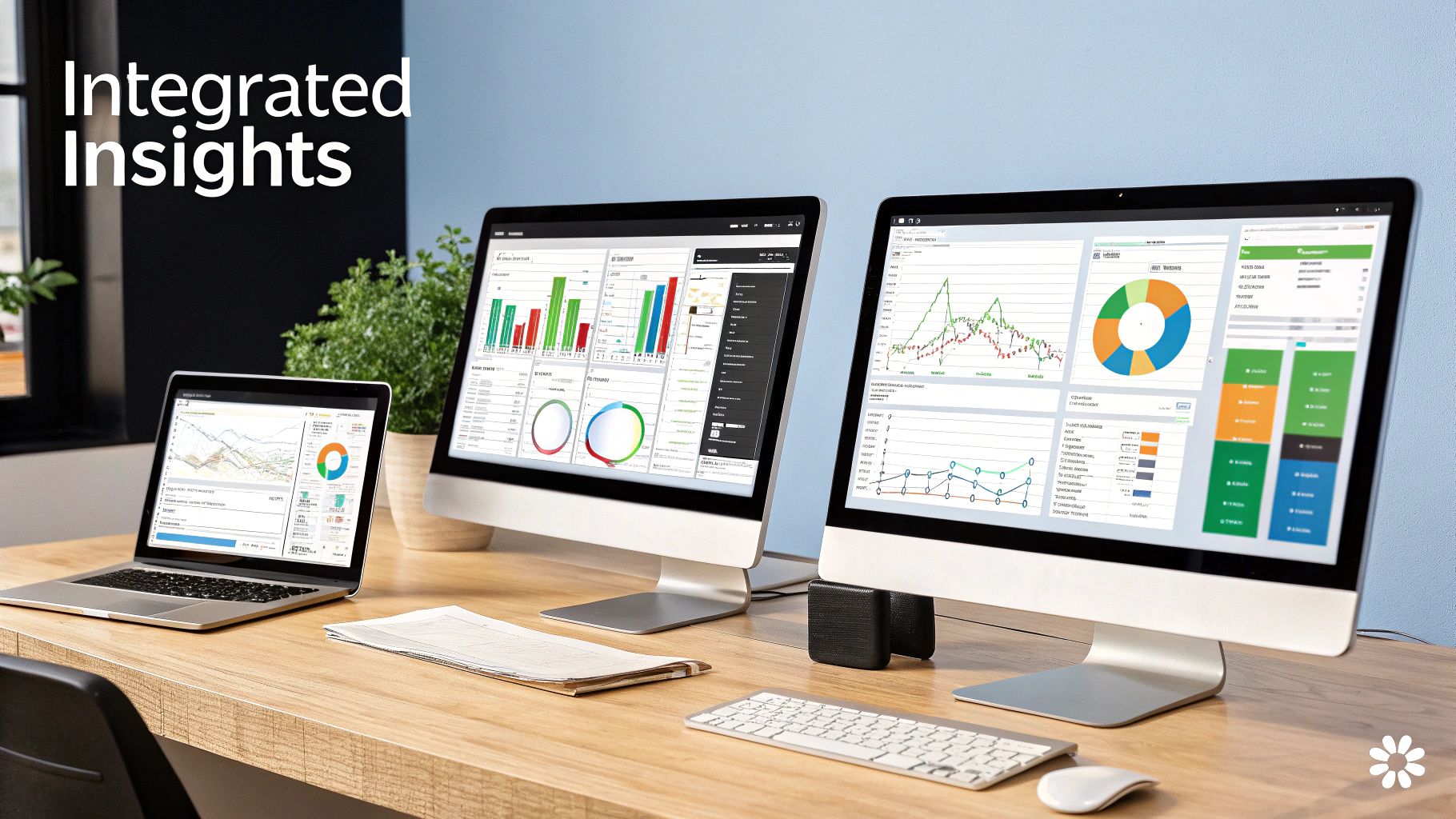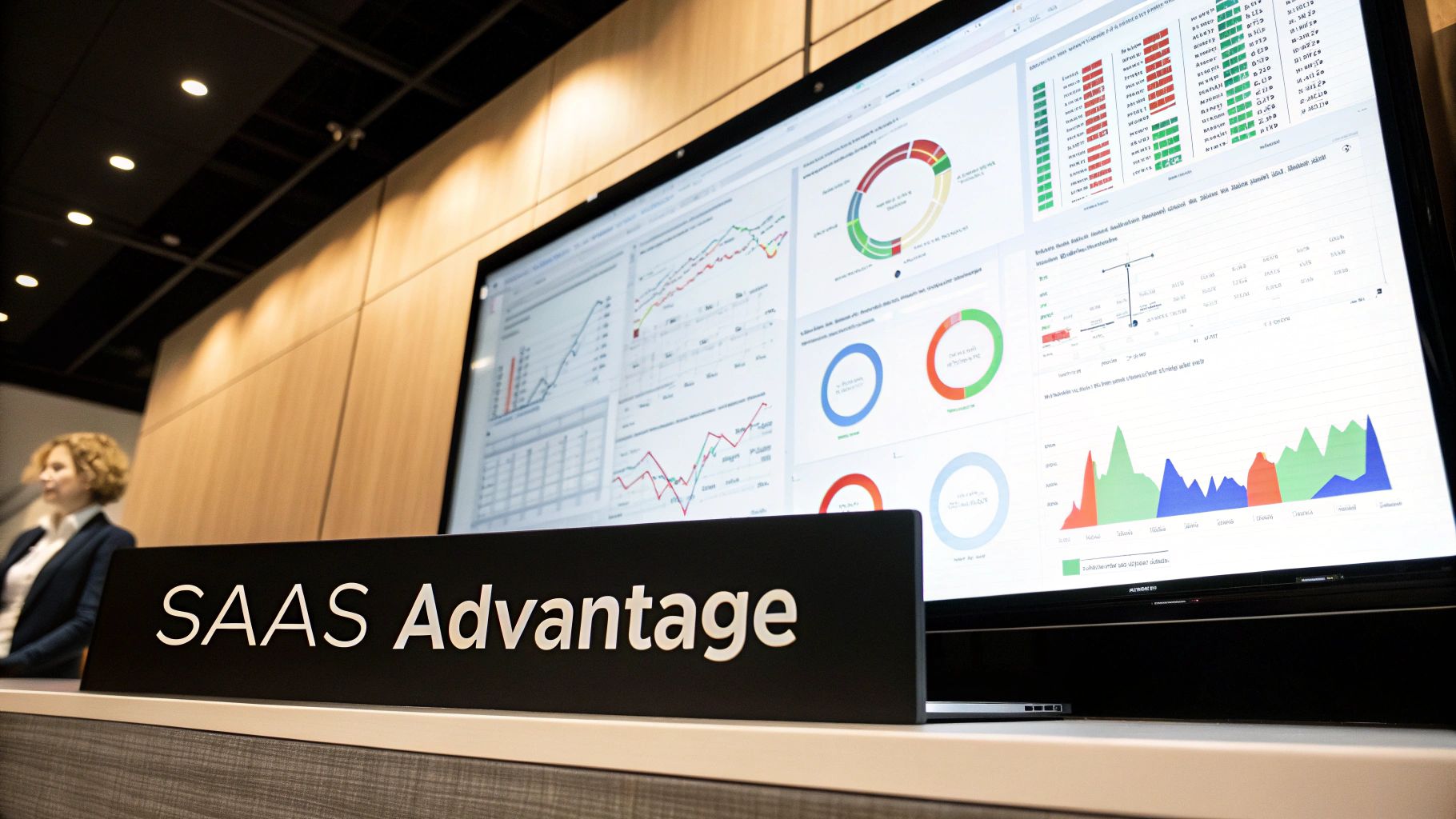The Real Power of Embedded Analytics for SaaS

Embedded analytics for SaaS applications is more than just a popular term. It represents a significant change in how businesses use data to empower their users. This method seamlessly integrates analytical features directly into your software, eliminating the need for users to jump between platforms. This improved experience is essential to realizing the full value of your data and improving user workflows. For a starting point on SaaS integrations, check out this guide: Getting Started With SaaS Integrations.
From Standalone Tools to Integrated Insights
In the past, accessing insightful data often meant exporting information and using separate analytics tools. This process was tedious and disconnected insights from actions within the SaaS application. Embedded analytics solves this problem by putting data analysis power directly into the hands of your users. For instance, instead of exporting sales figures to a spreadsheet, users can view interactive dashboards and create reports from within their CRM system.
Why This Matters for Modern SaaS
This move toward integrated insights is critical in today's competitive software market. By providing a seamless and data-rich experience, embedded analytics helps users make better decisions, more quickly. This leads to higher user engagement and greater customer satisfaction. Moreover, the ability to gain practical insights directly within the application makes for a more engaging product, promoting user loyalty and reducing customer loss. For further reading, consider: How to Master Affiliate Marketing.
Real-World Examples of Embedded Analytics in Action
Many SaaS categories use embedded analytics to enhance their user experience. Marketing platforms can display real-time campaign data within their dashboards, letting marketers adjust their strategies instantly. Financial tools can provide personalized investment insights and risk assessments, helping users make smarter financial choices. The embedded analytics market is predicted to grow significantly, from USD 69.60 billion in 2024 to approximately USD 182.72 billion by 2033. This signifies a CAGR of 12.82% between 2025 and 2033. More detailed information is available here. These practical examples demonstrate how embedded analytics provides real business value across various industries.
Beyond The Dashboard: Key Benefits That Drive Results

Embedded analytics for SaaS applications offers a powerful way to transform raw data into actionable insights directly within your software. Moving away from detached dashboards creates a more engaging and valuable user experience. But what specific benefits does this offer? This section explores the key advantages that impact your bottom line.
Enhanced User Engagement and Product Stickiness
Providing contextual insights at the point of need dramatically increases user engagement. When users see the direct impact of their actions through embedded analytics, they become more invested in the platform. This increased interaction fosters product stickiness, reducing user churn.
For example, a project management tool might show users how their task completion rates compare to team averages, directly within their workflow. This real-time feedback encourages users to stay engaged and contribute more effectively.
Increased Customer Lifetime Value and Premium Pricing
This enhanced engagement naturally leads to a longer customer lifetime value. When users consistently find value in your application, they're more likely to remain subscribers. Embedded analytics also opens doors for premium pricing strategies.
By offering advanced analytics features as part of a higher-tier subscription, you can cater to users with more sophisticated data needs and increase revenue. Using advanced analytics, like some of the available Shopify analytics tools, can give you a more comprehensive understanding of your data. This tiered approach maximizes the value derived from data-driven insights.
Measurable Improvements in User Satisfaction and Retention
Embedded analytics also yields measurable improvements in user satisfaction. Removing the friction of switching between platforms creates a smoother, more efficient user experience. This streamlined workflow results in higher satisfaction scores and better user retention.
Furthermore, embedded analytics is versatile and integrates with various business applications, including CRM and ERP systems. This integration transforms raw data into actionable business intelligence, boosting productivity, improving customer satisfaction, and creating a stronger competitive advantage.
Competitive Differentiation and Expanded User Adoption
Finally, embedded analytics offers significant competitive differentiation. In the crowded SaaS market, providing unique, data-driven features sets you apart. This added value attracts new users and broadens your market reach.
Empowering users with data transforms your product into a solution that helps them achieve their goals efficiently. This value proposition drives user adoption and solidifies your market position.
To further illustrate the advantages, let's examine the benefits by SaaS category:
Introduction to Table: The following table highlights the specific benefits of embedded analytics across different SaaS applications. This comparison demonstrates how incorporating data-driven insights can enhance user experience and drive business impact across diverse sectors.
| SaaS Category | Key Benefits | Business Impact | User Experience Improvement |
|---|---|---|---|
| Project Management | Real-time progress tracking, team performance comparison | Improved project delivery rates, increased team productivity | Streamlined workflows, data-driven decision making |
| Sales CRM | Lead scoring, sales forecasting, opportunity identification | Increased conversion rates, improved sales performance | Enhanced lead management, data-driven insights for sales strategies |
| Marketing Automation | Campaign performance analysis, customer segmentation, personalized marketing | Improved marketing ROI, increased customer engagement | Data-driven campaign optimization, personalized user journeys |
| Customer Support | Ticket analysis, customer feedback analysis, issue resolution tracking | Reduced resolution time, improved customer satisfaction | Proactive support, data-driven issue identification |
| E-commerce | Product recommendations, sales trend analysis, inventory management | Increased sales, optimized inventory levels | Personalized shopping experience, data-driven insights for product discovery |
Conclusion of Table: As shown in the table, the benefits of embedded analytics span various SaaS categories. By tailoring data insights to specific user needs within each application, businesses can achieve significant improvements in key metrics, ranging from user engagement and retention to overall business performance.
Making It Happen: Implementation Strategies That Work

This section provides a practical roadmap for incorporating embedded analytics into your SaaS application. We'll explore key decisions and potential hurdles you might encounter, from the initial build-versus-buy choice to deployment methods and data governance.
The Build Vs. Buy Decision: More Than Just Cost
One of the first crucial steps is determining whether to build or buy your embedded analytics solution. Building an in-house solution may initially seem attractive, offering seemingly complete control over customization. However, this path often involves unforeseen costs like lengthy development timelines and the continuous burden of maintenance. Opting for a pre-built solution, such as Refgrow, enables quicker implementation and reduces long-term costs, allowing you to concentrate on core product development. To assess the financial implications of implementing analytics, consider how to Calculate Lifetime Value SaaS.
Deployment Approaches: Choosing The Right Path
After deciding on the build-or-buy route, selecting the appropriate deployment strategy is essential. Seamless UI integration offers the best user experience, embedding analytics directly within your application's workflow. While Iframe solutions are generally simpler to implement, they can feel less integrated and present design inconsistencies. API-based approaches offer greater flexibility and scalability, making them well-suited to more complex integrations. The best approach depends on your specific needs and available resources.
Data Governance, Security, and Multi-Tenancy: Essential Considerations
Data governance and security are paramount when implementing embedded analytics. Ensuring data privacy and adhering to relevant regulations is non-negotiable. Secure access controls and data encryption are crucial for protecting sensitive information. In multi-tenant SaaS applications, effective data segregation is critical to prevent data leakage between tenants.
Technical Requirements and Realistic Timelines: Setting Expectations
Understanding technical requirements, including API compatibility and data visualization options, is essential for successful implementation. Establishing realistic timelines helps manage stakeholder expectations and promotes on-time project delivery. Breaking the project into smaller, manageable phases with clearly defined milestones for each stage is recommended. This incremental approach allows for continuous monitoring and adjustments during the implementation process.
Industry Solutions: How Different Sectors Leverage Analytics

Embedded analytics offers distinct advantages across various industries. This section explores how different sectors are using these capabilities to address specific business challenges and capitalize on new opportunities. Understanding these applications provides valuable insights for developing your own embedded analytics strategy. Learn more in our article about How to Master SaaS Affiliate Software.
Healthcare: Improved Patient Outcomes and Regulatory Compliance
In the healthcare sector, embedded analytics helps improve patient outcomes while maintaining strict compliance with regulations. Consider a hospital system using embedded analytics within its Electronic Health Record (EHR) software. Doctors can access real-time patient data, analyze treatment effectiveness, and identify potential risks, all within their existing workflow.
This data-driven approach empowers healthcare professionals to make more informed decisions, potentially leading to better patient care and a reduction in medical errors. It also simplifies adherence to complex regulatory requirements.
Financial Services: Enhanced Risk Management and Fraud Prevention
Financial services firms rely heavily on embedded analytics for risk assessment, fraud detection, and customer profiling. For example, a bank can integrate analytics into its loan origination software. This enables loan officers to analyze applicant data, assess creditworthiness, and identify potential fraud indicators directly within the application.
This real-time analysis streamlines the loan process and minimizes financial risks. It also enhances the accuracy and speed of fraud detection, a critical concern in this industry.
Retail and E-commerce: Personalized Customer Experiences and Increased Sales
Retail and e-commerce businesses utilize embedded analytics to understand customer behavior and provide truly personalized experiences. By analyzing purchase history, browsing patterns, and product preferences, businesses can tailor product recommendations and marketing campaigns to individual consumers.
This level of personalization fosters customer loyalty and boosts sales conversions. It creates a more engaging and relevant shopping experience, leading to increased customer satisfaction and repeat business.
Manufacturing: Optimizing Processes Through Predictive Maintenance and Quality Control
In manufacturing, embedded analytics plays a vital role in predictive maintenance and quality control. By embedding analytics into their production management systems, manufacturers can monitor equipment performance in real time. This allows them to predict potential equipment failures, schedule preventative maintenance, and avoid costly downtime.
Data-driven quality control processes also help identify and address production issues before they impact the final product, leading to higher quality and reduced waste.
To better understand the practical applications of embedded analytics, let's look at some specific examples across these industries. The following table provides a closer look at common use cases, key metrics, and the resulting business outcomes.
Embedded Analytics Applications Across Industries
| Industry | Common Use Cases | Key Metrics Tracked | Business Outcomes |
|---|---|---|---|
| Healthcare | Patient risk assessment, treatment effectiveness analysis, compliance reporting | Readmission rates, patient satisfaction scores, regulatory compliance rates | Improved patient outcomes, reduced medical errors, enhanced regulatory compliance |
| Financial Services | Loan risk assessment, fraud detection, customer profiling | Loan default rates, fraud detection rates, customer lifetime value | Reduced financial risk, improved fraud prevention, enhanced customer relationships |
| Retail and E-commerce | Personalized product recommendations, targeted marketing campaigns, inventory optimization | Conversion rates, customer lifetime value, inventory turnover rate | Increased sales, improved customer loyalty, optimized inventory levels |
| Manufacturing | Predictive maintenance, quality control, supply chain optimization | Equipment downtime, product defect rates, supply chain efficiency | Reduced production costs, improved product quality, optimized supply chain performance |
As this table shows, the application of embedded analytics is widespread and delivers significant benefits across diverse sectors. By focusing on relevant key metrics and tailoring the use cases to specific business needs, organizations can leverage embedded analytics to achieve their unique objectives and gain a competitive edge.
Future-Proofing: Emerging Trends in SaaS Analytics
The world of embedded analytics for SaaS is constantly evolving. This section explores key technologies reshaping the landscape and how these trends will change how we interact with data within SaaS applications.
The Rise of AI and Machine Learning
Artificial intelligence (AI) and machine learning are transforming basic reporting into predictive insights. These technologies move beyond simply presenting data; they analyze it to identify patterns, predict future trends, and offer proactive recommendations. This allows users to anticipate challenges and opportunities, leading to more strategic decision-making. Instead of just seeing what happened, users can understand why it happened and what's likely to happen next.
For example, imagine a SaaS marketing platform using AI to predict campaign performance based on historical data and current market conditions. This empowers marketers to proactively optimize their campaigns, maximizing their return on investment.
Natural Language Interfaces: Democratizing Data Access
Natural language interfaces are making data more accessible to non-technical users. By allowing users to interact with data using everyday language, these interfaces eliminate the need for complex query languages or technical expertise. This democratization of data access empowers a wider range of users within an organization to leverage insights, driving broader product adoption and increasing the overall value of the SaaS offering. Now, anyone can ask questions of their data and get meaningful answers, regardless of their technical skills.
Imagine a sales representative asking their CRM, "Which leads are most likely to convert this quarter?" and receiving a prioritized list without having to build complex reports.
Real-Time Analytics: Powering Time-Sensitive Decisions
The demand for real-time analytics is rapidly increasing in the SaaS world. Businesses need up-to-the-minute data to make informed, timely decisions. Leading SaaS providers are incorporating real-time analytics without impacting performance, ensuring users have access to the most current information when they need it. This immediacy is crucial for businesses operating in dynamic, ever-changing markets.
For instance, a logistics company could use real-time analytics within their SaaS platform to track shipments, monitor delivery progress, and proactively address potential delays.
Consistent Cross-Device Experiences: Accessing Insights Anywhere
Successful SaaS providers are prioritizing consistent analytics experiences across devices. Whether users are on their desktop, tablet, or mobile phone, they expect the same seamless, data-rich experience. This ensures insights are available whenever and wherever decisions are made, increasing flexibility and responsiveness. This also means ensuring data visualizations are optimized for various screen sizes and maintaining an intuitive user interface across devices.
Users expect consistent functionality across all devices, including access to the embedded analytics. By prioritizing cross-device compatibility, SaaS providers improve the user experience and enable a truly mobile and connected workforce. This leads to a more productive and engaged user base, maximizing the value of the embedded analytics features.
Choosing Your Perfect Analytics Partner
Selecting the right embedded analytics solution for your SaaS platform is a critical decision impacting long-term success. With so many vendors competing for your attention, finding the ideal partner can feel overwhelming. This guide offers a practical framework for navigating this decision-making process.
Essential Features: Beyond the Hype
Don't be swayed by flashy marketing. Prioritize features that directly address your specific business needs. Customization is key. Your chosen solution should integrate smoothly with your current user interface and existing workflows. Robust security measures, such as data encryption and stringent access management, are essential for protecting sensitive user data. Finally, carefully consider the available visualization options. Interactive dashboards, customizable reports, and clear, concise charts empower users to glean meaningful insights from their data.
Technical Considerations: The Long-Term View
Several technical factors significantly influence the long-term success of your embedded analytics solution. API flexibility is crucial for seamless integration with your current systems and allows for future scalability. Performance with large datasets is paramount, especially as your user base and data volume expand. Ensure the solution can handle increasing loads without compromising speed or responsiveness.
Key Questions: Pricing, Support, and Implementation
Before committing to a vendor, thoroughly investigate their pricing structure. Some vendors charge per user, while others offer tiered plans based on features or data usage. Understand the level of support offered, including available documentation, training resources, and technical assistance. Don't underestimate the importance of implementation support. A smooth onboarding experience and readily available support can significantly accelerate time-to-value. Learn more about pricing and other crucial considerations on our pricing page.
Proof-of-Concept and Stakeholder Involvement: Best Practices
Conducting a proof-of-concept evaluation is highly recommended. This allows you to test the solution in a real-world setting and assess its effectiveness for your specific use cases. Engage key stakeholders, including product managers, developers, and end-users, throughout the selection process. This ensures alignment between the chosen solution and the needs of everyone involved. For further insights, explore our blog post on How to Master SaaS Affiliate Software.
Refgrow provides a powerful, customizable, and easily integrated embedded analytics solution designed for SaaS platforms. Launch your affiliate program quickly, boost conversion rates, and drive growth. Learn more and begin your free trial today!

